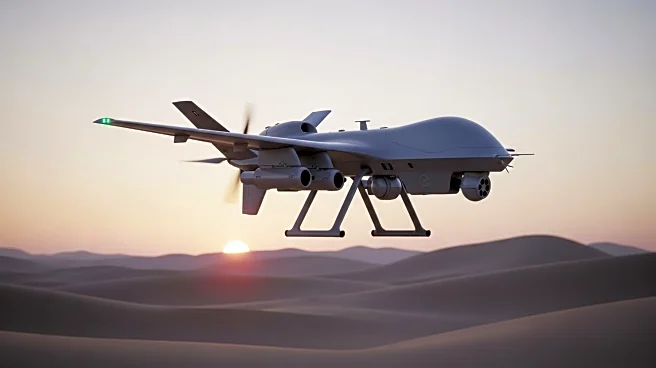What is the story about?
What's Happening?
Vlatacom Institute, a private Serbian company, showcased its vMOAB-4t concept at the Partner 2025 defense exhibition in Belgrade. The vMOAB-4t, which stands for Massive Ordnance Air Blast, is designed to be launched from Boeing C-17 or Lockheed Martin C-130 transport aircraft. The bomb features a high-explosive fragmentation warhead available in 4, 7, and 10-tonne variants. The deployment process involves a specially designed cradle and parachute system to ensure precision targeting. The bomb is intended for the destruction of soft- or medium-fortified surface targets, such as command-and-control centers. The concept includes a proximity sensor to activate the warhead above the surface, maximizing its destructive potential.
Why It's Important?
The introduction of Vlatacom's vMOAB-4t concept highlights advancements in military technology and strategic capabilities. This development could impact defense strategies in the Middle East, where the bomb is intended for use. The ability to precisely target and destroy fortified positions enhances military effectiveness and could shift power dynamics in the region. For the U.S., this innovation may influence defense collaborations and technology sharing with allies, as well as impact military procurement decisions. The concept's reliance on global navigation satellite services underscores the importance of technological integration in modern warfare.
What's Next?
The unveiling of the vMOAB-4t concept may lead to further interest and potential contracts from Middle Eastern countries seeking advanced military capabilities. Vlatacom's presentation could prompt discussions on international defense partnerships and technology transfers. Additionally, the concept's deployment method and precision targeting may inspire similar innovations in other defense sectors. Stakeholders, including military leaders and defense contractors, will likely monitor the reception and potential adoption of this technology closely.
Beyond the Headlines
The development of the vMOAB-4t concept raises ethical considerations regarding the use of advanced weaponry in conflict zones. The ability to precisely target and destroy fortified positions may lead to debates on the humanitarian impact and the potential for collateral damage. Furthermore, the integration of global navigation systems in military technology highlights the increasing reliance on digital infrastructure, raising concerns about cybersecurity and the vulnerability of such systems to interference.
AI Generated Content
Do you find this article useful?















